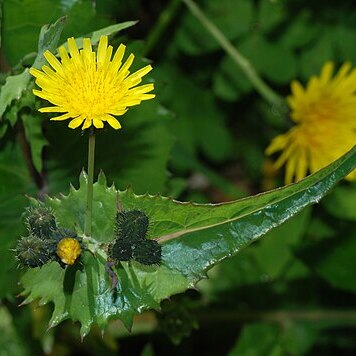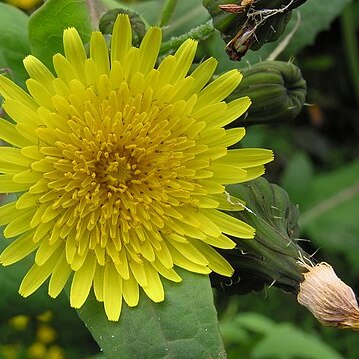Fls all ligulate and perfect, yellow, few to more often numerous (80+ in all our spp.); invol ovoid or campanulate, rarely narrower, its bracts generally imbricate, occasionally merely calyculate, often basally thickened in age; achenes flattened, 6–20-ribbed, merely narrowed at the tip, beakless, glabrous, often transversely rugulose; pappus of numerous white, capillary, often somewhat crisped bristles that tend to fall connected, and some stouter outer bristles that fall separately; lactiferous herbs with alternate or all basal, entire to dissected, mostly auriculate, often prickly-margined lvs, and solitary to usually several or many, medium-sized to rather large heads in an irregularly corymbose-paniculiform to subumbelliform infl. 50, Old World.
Herbs or subshrubs; stems erect or scrambling, often hollow. Leaves alternate, often pinnatifid or pinnatisect; basal (root-crown) leaves smaller. Capitula in corymbs or panicles, rarely solitary; involucre cylindrical to spreading, often woolly at base; phyllaries in several series, imbricate, the outermost smallest and becoming swollen at base; receptacle epaleate, pitted. Florets many; corolla yellow; anthers sagittate at base; style branches with minute sweeping hairs. Achenes compressed, few-ribbed; pappus of mixed bristles and fine hairs.
Annual, biennial or perennial herbs, branching, sometimes glaucous. Hairs simple, glandular and eglandular. Leaves basal and cauline. Inflorescences cymose. Capitula pedunculate; involucral bracts multiseriate, not hardening, reflexed at maturity. Florets: ligules yellow (in Australia). Achenes homomorphic, moderately to strongly compressed, unbeaked. Pappus of bristles, partially persistent; bristles nearly smooth or scabridulous, of 2 types within pappus.
Capitula many-fld, in terminal subcorymbose to umbellate panicles, homogamous; phyll. imbricate in several series; receptacle flat, nude; florets ligulate, yellow. Achenes ± compressed, ribbed, not beaked; pappus of cop. soft slender hairs. Erect lfy annual to perennial herbs with cop. latex. About 40 spp. of temperate regions, some widespread; the N.Z. spp. endemic.
Achenes reddish-brown, narrowly obovoid to ellipsoid, ± compressed, glabrous, without a beak, ribbed; ribs 1–4, often with secondary ribs between, uniformly narrow, eventually ± swollen, or marginal ribs wing-like, smooth, rugulose or retrorsely and minutely tuberculate.
Leaves alternate, cauline, undivided or runcinate to pinnately-lobed, ± auriculate to sagittate, margins subentire or acicular-denticulate to irregularly and sharply dentate; basal leaves smaller, less dissected.
Florets numerous, yellow, the ligule sometimes reddish outside with age; anthers sagittate at the base with the auricles shortly setaceous-acuminate; style branches medium to long, sweeping hairs small.
Stems erect, sometimes scrambling, mostly solitary, branched above, leafy throughout or leaves ± crowded below, hollow (at least in the Flora Zambesiaca area).
Phyllaries several-seriate, imbricate, densely tomentose to glabrescent, sometimes glandular-setose outside, the outer eventually ± swollen at the base.
Involucres 1–2 times as long as broad, cylindric-campanulate to spreading, ± persistently tomentose below, sometimes glabrous.
Capitula few in terminal clusters, or many in lax compound corymbs, sometimes solitary, stalked or some subsessile.
Pappus several-seriate, dimorphic of stiff straight setae intermixed with down-like hairs.
Annual, perennial or biennial herbs.
Receptacle pitted, epaleate.


